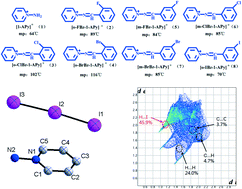Synthesis, structure and Hirshfeld surface analysis of a series of novel low melting salts without alkyl groups†
Abstract
Eight ion-pair compounds, [1-APy]I3 (1), [o-FBz-1-APy]I3 (2), [o-ClBz-1-APy]I3 (3), [o-BrBz-1-APy]I3 (4), [m-FBz-1-APy]I3 (5), [m-ClBz-1-APy]I3 (6), [m-BrBz-1-APy]I3 (7) and [m-IBz-1-APy]I3 (8), were synthesized and characterized structurally. The melting point of 1, 2 and 5–8 is below 90 °C and hence these compounds can be used as ionic liquids. A common characteristic of the crystal structures of 1–8 is that the inorganic components form a linear I3− anion and the non-planar Schiff base cations surround the anion to form molecular stacks. There exist H⋯I hydrogen bond contacts between the cations and I3− anion in the eight compounds, and H⋯H interactions are the main force between the cations. The melting point of crystal 1 is the lowest with 64 °C among the eight compounds. 3 and 4 show higher Tm, ΔHfus and ΔSfus values. The substituent group of the Schiff base cation in the meta-position can also decrease the melting point of the compounds. In addition, Hirshfeld surface analysis was used to understand the intricacies of interactions occurring in the eight compounds, and the relationship between the melting point and the weak interaction was discussed.

- This article is part of the themed collection: Supramolecular & Polymorphism


 Please wait while we load your content...
Please wait while we load your content...